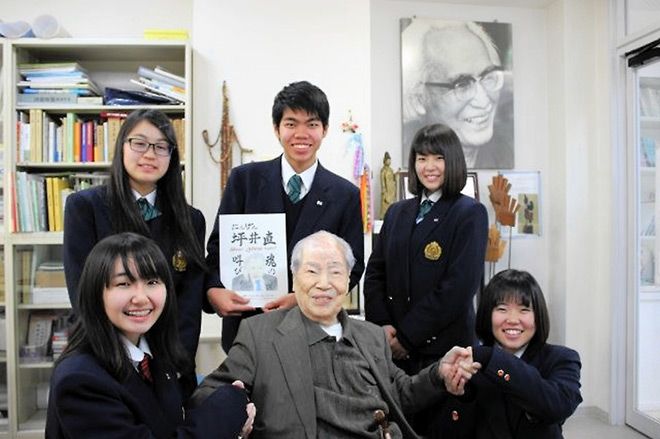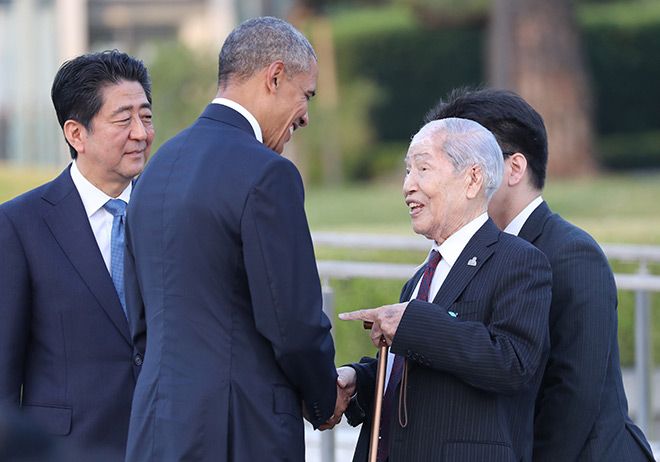The anti-nuclear baton is fast passing to young Japanese as hibakusha become part of history.
Time and again, the younger generation refer to lectures and other events they attended in senior high school where they heard firsthand what atomic bomb survivors had endured.
Those survivors now have an average age of 85.
OVERCOMING HATRED
Japanese by and large were glued to their TV screens when U.S. President Barack Obama made his historic visit to Hiroshima in May 2016.
In the hibakusha community, there was tremendous interest in whether the first sitting president to visit the city would apologize for the Aug. 6, 1945, bombing, or be asked for an apology.
One of those greeting Obama at the Hiroshima Peace Memorial Park ceremony was Sunao Tsuboi (1925-2021), who for many years was a co-chair of Nihon Hidankyo (the Japan Confederation of A- and H-Bomb Sufferers Organizations), the recipient of this year’s Nobel Peace Prize.
After Obama spoke at the ceremony, Tsuboi shook his hand and thanked him for coming to Hiroshima.
Yuta Takahashi, 24, then in his first year of senior high school, called Tsuboi later and still remembers what he said.
Takahashi asked Tsuboi whether he harbored hatred toward the United States.
Tsuboi responded: “Of course, I felt a lot of hatred from the bottom of my heart. But we have to overcome that because I pray for the happiness of all mankind.”
Two months before meeting Obama, Tsuboi was asked by Takahashi and his senior high school classmates to talk about his experience as a hibakusha. Tsuboi talked to the high school group for about five hours.
Tsuboi, who was 20 years old at the time, was about 1.2 kilometers from ground zero when the atomic bomb detonated over the western Japan city. He was burned over most of his body and was unconscious for about seven weeks.
Tsuboi went on to become a junior high school teacher after the war. He was diagnosed in critical condition on three occasions. But he overcame his anemia and other health problems and continued to talk about his experience.
After retiring as a teacher, Tsubo went overseas on 21 occasions, including to the United States, to attend review conferences for the Nuclear Nonproliferation Treaty.
 Yuta Takahashi, center back row, and senior high school classmates meet with Sunao Tsuboi, center front row, in December 2017. (Provided by Yuta Takahashi)
Yuta Takahashi, center back row, and senior high school classmates meet with Sunao Tsuboi, center front row, in December 2017. (Provided by Yuta Takahashi)
During those visits, Tsuboi met with Americans who told him that they, too, bore scars from the war.
Tsuboi came to the realization that only hurling hatred at each other would not change things.
A year after Takahashi and his group heard from Tsuboi, they put together a pamphlet of what he said and presented it to Tsuboi.
According to Takahashi, Tsuboi was overjoyed and told them, “I’m counting on you young people.”
To Takahashi, that sounded like Tsuboi’s last testament to them.
After graduating from university, Takahashi established Katawara, which seeks the abolition of nuclear weapons. The group was active when the Group of Seven summit was held in Hiroshima. It also held talks with ruling party Diet members, including those who harbor different opinions about nuclear weapons.
According to the health ministry, around 370,000 people held hibakusha health certificates in fiscal 1980, but that figure had fallen to 106,825 as of March. The average age of hibakusha is now 85.58.
In awarding Nihon Hidankyo with this year’s Nobel Peace Prize, the Nobel Committee described hibakusha as “historical witnesses.”
REACHING OUT TO ALL HIBAKUSHA
Hiroshima resident Haruko Moritaki, 85, takes the view that the Nobel Peace Prize should now spur the organization to make even greater efforts.
After retiring as a junior high school employee, she became a co-leader of the Hiroshima Alliance for Nuclear Weapons Abolition, which was established in 2001. The group had long championed an international treaty to ban nuclear weapons.
Her father, Ichiro, who died at age 92 in 1994, once led Nihon Hidankyo. He lost sight in his right eye when he was a professor at the Hiroshima higher school of education located about 4 km from ground zero.
Ichiro also lobbied the government to pass a law to provide support to hibakusha. He took part in around 500 sit-ins at the Hiroshima Peace Memorial Park to protest nuclear tests held around the world.
Initially, Haruko disliked being referred to simply as “Ichiro Moritaki’s daughter.”
But that gradually disappeared as she got older and became more aware of her father’s mantra that passing on one’s experience was very important. At gatherings, she made a point of calling on young people to hear their views.
Four years ago, Keita Takagaki, 22, was in the audience when Moritaki was speaking. At the time, he was on the staff of his senior high school’s newspaper.
 Haruko Moritaki speaks about her experiences working to abolish nuclear weapons. (Jun Ueda)
Haruko Moritaki speaks about her experiences working to abolish nuclear weapons. (Jun Ueda)
This year, Takagaki attended an Aug. 6 anniversary event. Since going on to university, Takagaki has tried to learn more about nuclear issues. He has visited the Marshall Islands and Kazakhstan, where the United States and the former Soviet Union conducted nuclear tests.
Encouraged by Takagaki’s efforts, Moritaki plans to invite hibakusha from around the world to a forum she wants to organize in Hiroshima next autumn.
It would be the first such gathering in 10 years.
Moritaki hopes the meeting will lead to greater awareness of the nuclear threat facing the world. On a personal level, it will allow her to recall what her father told her many years ago.
“Nuclear weapons and humanity cannot coexist.”
(This article was written by Yuhei Kyono and Hayashi Yanagawa.)
